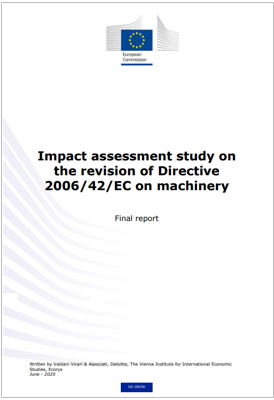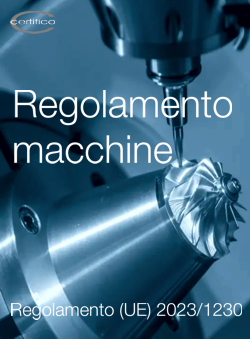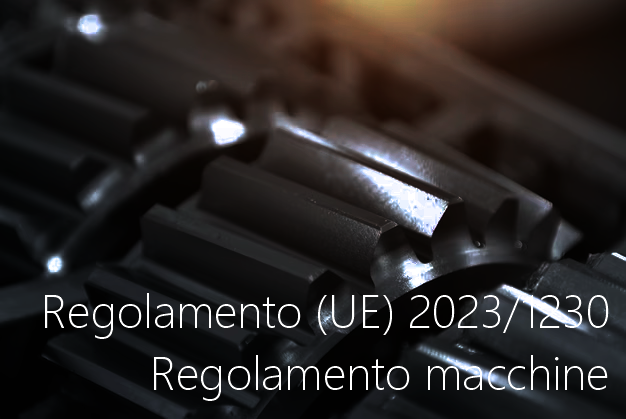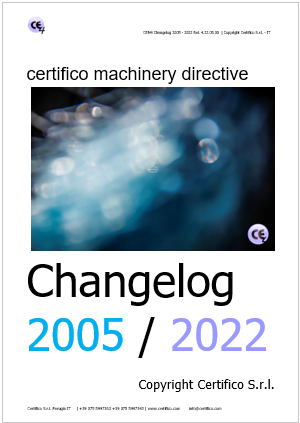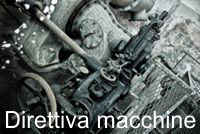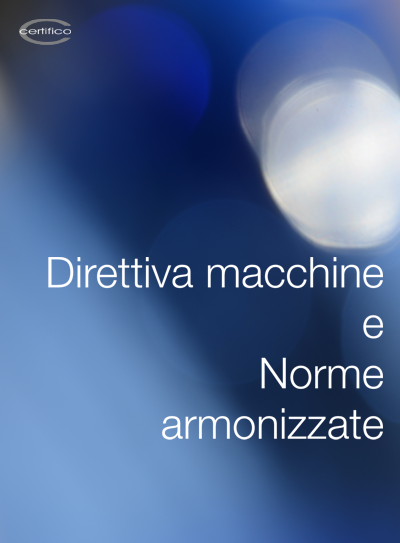Study on the revision of Directive 2006/42/EC on machinery
Impact assessment study on the revision of Directive 2006/42/EC on machinery
EC, June 2020
The scope of the study is to assess the impacts of the different policy options identified in view of choosing the most cost-effective policy option that ensures a high level of health and safety. The geographic scope of this study was the 2019 composition of the European Union (i.e. including the UK) and the EEA as a whole.3 It also examined relevant existing laws and initiatives at international level, especially in significant market such as the US, Japan, South Korea and China, as well as how international standards contribute to the competitiveness of the European machinery sector.
The issues to be addressed, identified by the REFIT evaluation, were:
- The need to carry out further analysis concerning the Directive’s fitness for the Internet of Things, Artificial Intelligence, new generation of autonomous robots and cybersecurity; and
- The need for a clear and stable legal framework that positively contributes to the development of the (digital) single market for the economic operators, in order to manage their economic activities more effectively and improve their competitiveness on global markets.
These three main issues were further developed and targeted to the concrete aspects that were identified as needs to a revision. These aspects fed into the development of the policy options to assess, described in more detail in this report. They included:
- Addressing new challenges and risks posed by technological developments in digitisation;
- Addressing in detail the problems identified during the evaluation of the Machinery
Directive, with a concrete focus on the following aspects:
- A missing alignment of the Machinery Directive to the New Legislative Framework (NLF);
- Adapting the scope and definitions, in particular with regards to the list of lowvoltage products excluded and the definition of Partly Completed Machinery, as well as the threshold speed of slow-speed lifts and the relationship with the Pressure Equipment Directive;
- Adapting the requirements for fully enclosed carrier or hold-to-run control with regards to slow-speed lifts; and
- Allowing digital formats for documentation.
- Modifying Annex IV on high-risk machinery and their conformity assessment with internal checks; and
- Conversion of the Directive into a Regulation.
Throughout the assessment study, other aspects were raised by stakeholders that could be considered for a revision. These have also been summarised in the report. However, a more in-depth assessment of those aspects may be conducted in the future, if needed.
As specified in the Terms of Reference, this report presents the main results of the fieldwork and analysis conducted. Following the format outlined in the Toolbox 12 under the Better Regulation Guidelines, the report is divided into the following chapters:
1. Chapter 2 – What is the problem and why is it a problem?
2. Chapter 3 – Why should the EU act?
3. Chapter 4 – What should be achieved?
4. Chapter 5 – What are the various options to achieve the objectives?
5. Chapter 6 – What are the impacts of the different policy options and who will be affected?
6. Chapter 7 – How do the options compare?
7. Chapter 8 – Preferred policy options
8. Chapter 9 – How would actual impacts be monitored and evaluated?
9. Annexes
In order to understand the aspects assessed in this report, the following section provides an overview of the machinery market, including trends in digitalisation, a description of two main aspects with regards to the scope, the list of low-voltage products and slow-speed lifts, as well as the role that harmonised standards play in the application of the Directive.
The Directive 2006/42/EC on Machinery is the core legislation regulating products of the mechanical engineering industries. It was adopted on 17 May 2006 and implemented in 2009. The Directive was the result of a comprehensive revision of previous legislation dating back to the first Directive 89/392/EEC, which was reviewed in 1991 and 1993, and the second Directive 98/37/EC.
The general objectives of the 2006 Machinery Directive (MD) are to:
1. Ensure free movement of machinery within the internal market; and
2. Ensure a high level of protection for users and other exposed persons.
With the amendment 2009/127/EC, a third objective was added:
3. Ensure the protection of environment in the context of using machinery for pesticide application.
The MD aims to ensure a high level of protection for workers, final users and other exposed persons by focusing on the safety of machinery itself. In practice, this translates into mandatory Essential Health and Safety Requirements (EHSR), including conformity assessment procedures based on product risk. The detailed technical requirements to comply with the EHSR are not enshrined in the MD but must be applied by the manufacturers via “harmonised standards” or other technical specifications under certain conditions as explained in section 1.2.5.
This kind of approach differs from other pieces of legislation aimed also at increasing health and safety. In fact, these often focus on detailed requirements for persons dealing with specific products at a specific time of the production/consumption process. For instance, this is the case of Directive 2009/104/EC, which lays down specific minimum health and safety requirements for the use of work equipment. In contrast with a regulatory approach, in other areas self-regulation can be found, characterised by the development of voluntary codes of practice or standards developed by the industry, with the industry solely responsible for enforcement.
The objective of this study is limited to the scope and approach of the MD, assessing and developing its ability to deal with new and specific risks, as identified in section 2, in the fulfilment of its goals.
The scope of the MD covers a wide range of products. Machinery is broadly defined as an assembly “of linked parts or components, at least one of which moves”, which is applicable to a great variety of products, from lawnmowers to 3D printers, from powered hand-tools to construction machinery, and from robots to complete automated industrial production lines.
The MD applies across the whole value chain, from the design and manufacturing until the placing on the market of the machinery for consumer and professional use. The machinery manufacturers must take the appropriate measures to eliminate any risk throughout the foreseeable lifetime of the machinery including the phases of transport, assembly, dismantling, disabling and scrapping.
Some products are explicitly excluded from the scope of the MD. This is the case, for instance, for some products that fall under the scope of the Low Voltage Directive (LVD), as listed in Art. 1.2(k) of the MD. In other cases, the MD may apply together with or even alternatively to other pieces of legislation. The issues are whether, and to what extent, the MD overlaps with other pieces of legislation, exceptions create legal uncertainty and whether there are differences in market surveillance and thus distorted competition.
This study was conducted to support the European Commission services in carrying out an impact assessment on a revision of the Directive 2006/42/EC on machinery. The revision of the MD results from the REFIT evaluation2 on the necessity to improve, simplify and adapt the Directive to the needs of the market.
The general objectives of the revision of the Directive are to:
2. Establish a high level of trust in digital innovative technologies for consumers and users.
The specific objectives of the revision are to:
- Align the Directive to the New Legislative Framework (Decision 768/2008);
- Preserve the technology neutral principle allowing the use of innovative technologies as far as safety is ensured;
- Reduce administrative requirements related to documentation; and
- Cover new risks related to digital emerging technologies.
add more
Related
Directive 2006/42/EC
- Pubblicato: 01 Settembre 2020
- Visite: 22642





